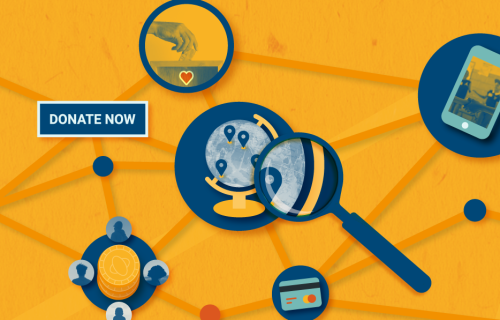What does fundraising mean to you? Perhaps it is your daily job or you consider it a necessity - or maybe even a headache. But did you know that fundraising is a right?
By the end of this package, you will:
- Understand the importance of income diversification;
- Have an in-depth overview of different ways of fundraising and new developments based on digital technologies;
- Have a better understanding of the legal challenges CSOs are facing related to fundraising;
- Know which laws and international standards enable giving.
Fundraising represents the power of people to create a better world. It supports activism and the engagement of individuals and communities in that process. Fundraising ensures resources for the existence of grassroot activists, social movements, and CSOs, who tirelessly work to help shape open societies, provide services and protect our rights and freedoms. The right to form such groups and organisations is protected under international law and it is widely recognised that the right to freely access human, material and financial resources is inherent in this right.
Providing an enabling legal environment for giving is key to ensure activists and CSOs can mobilise resources. This learning package is designed to help you gain a general understanding of fundraising concepts and methods, as well as relevant laws and regulations, which you can then build on as you explore the upcoming thematic modules.
Please note that this is not a fundraising course: if you want to learn how to raise resources we recommend to take a look at fundraising courses offered in your country or the open-source Change the Game Academy.
CSOs can raise income from various sources. These include grants from bilateral and multilateral donors, grants from private foundations or other CSOs (e.g. international non-governmental organisations), funding from national or local governments, donations from individuals, corporate partners, income-generating activities and social enterprise models. In some countries, CSOs can benefit from a percentage designation mechanism.
Ideally, a financially resilient CSO combines a mix of income sources: this makes an organisation less vulnerable and helps spread risks. Moreover, different types of funding bring different benefits and challenges. For example, income-generating activities require specific expertise and considerable time investment, but, if successful, they can generate flexible funding that can be used to cover administrative costs.
However, in many countries, the majority of CSOs rely mostly on grants from institutional donors (governments, bilateral and multilateral donors). These are indispensable sources of funding, often involving considerable amounts. Moreover, partnerships with institutional donors can lead to further benefits as well, such as advancing a CSO’s mission through providing access to information or networks. However, overreliance on grants is also associated with several challenges:
- Accessibility. Generally speaking, smaller CSOs face greater difficulties to access these resources, as it is hard for them to compete with bigger CSOs and meet the -often stringent - donor criteria. For example, a report concluded based on OECD data that less than 1% of Official Development Assistance committed to gender equality between 2017 and 2019 reached grassroots feminist movements.
- Sustainability. Grants are often project-based and donors or intermediary organisations make decisions on how the resources should be utilised, thus impeding CSOs’ ownership and their ability to invest in their institutional sustainability, as a study conducted among youth organisations in majority countries indicates. However, within the philanthropic sector, there is growing awareness that other ways or working are needed: see for example the work of the trust-based philanthropy project.
- Legitimacy. CSOs that solely rely on grants may overlook the importance of building a constituency of people that support that work. Having a local constituency not only strengthens their financial viability, but also their credibility and legitimacy. Research has confirmed that an overreliance on grants can undermine CSO legitimacy.
Altogether, it is key for CSOs to diversify their income and mobilise resources and support from different sources, including contributions from individuals. In our learning packages, we will focus on private giving: gifts from individuals, groups and companies. However, some of the concepts, challenges and associated regulations described also apply to income from grants.
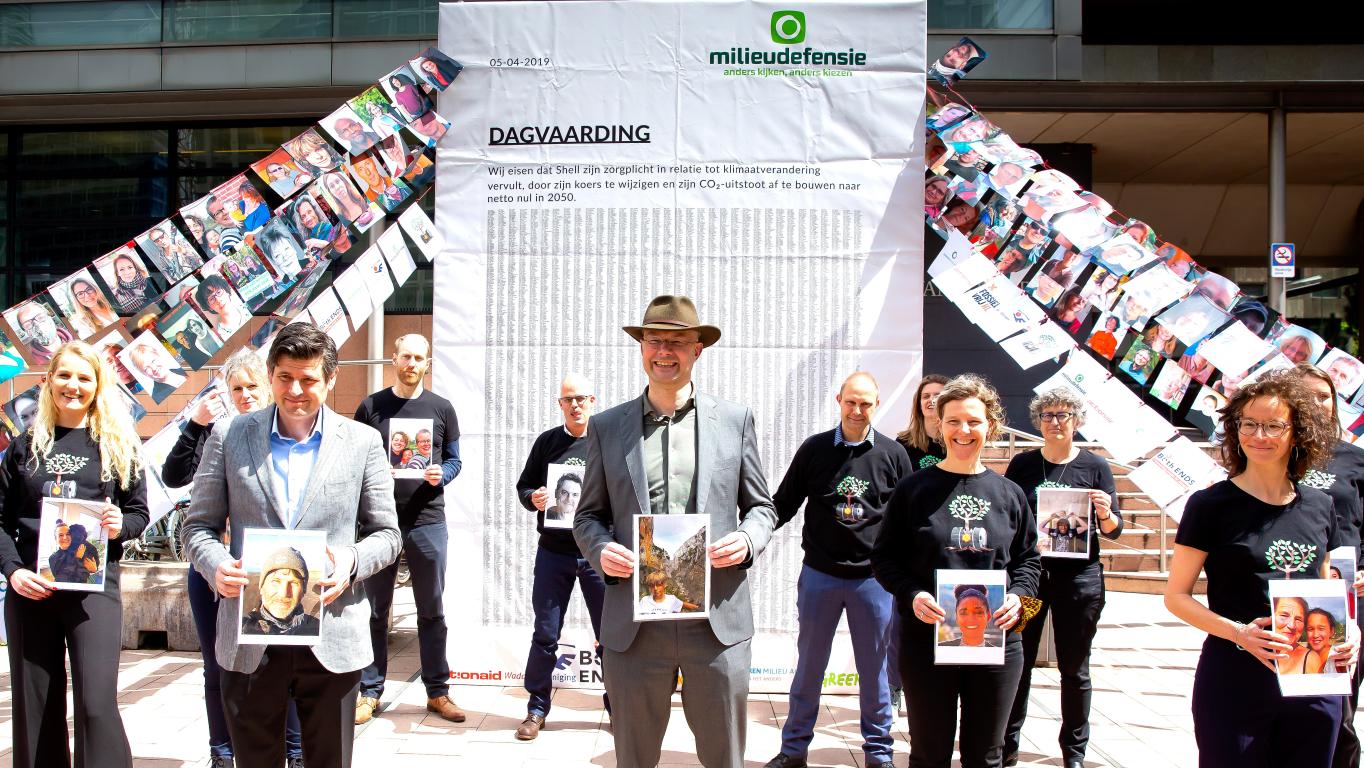
A striking example of a fundraising and constituency building campaign comes from the Dutch environmental CSO Milieudefensie (Friends of the Earth Netherlands). In 2018, Milieudefensie announced a lawsuit against Shell in a groundbreaking climate case, stating that Shell’s contributions to climate change violate its duty of care under Dutch law and human rights obligations. Dutch citizens were invited to join the court case as co-plaintiffs and donate a small amount towards litigation cost. More than 17,000 Dutch citizens symbolically became co-plaintiffs, as well as 6 other Dutch CSOs. This helped Milieudefensie mobilise resources for the case but also enabled them to show that the case was widely supported. Milieudefensie won the case and in the landmark ruling, the Hague district court ordered Shell to reduce its CO2 emissions by 45% by 2030 compared to 2019 figures.
Shell did appeal this ruling. On 12 November 2024 the court of appeal ruled that "while Shell does have a “special responsibility” to cut its emissions as a big oil company, this would not be achieved by imposing a specific legal goal."
Reflect on what you have learnt:
- What are your organisation’s sources of funding?
- What are the advantages and challenges associated with these funding sources?
- What would your income division ideally look like?
If you want to diversify your income, consider these 5 useful steps.
Do you give money or time to a CSO? Do you remember how you were approached by this organisation or what convinced you to contribute? Soliciting funds from individuals, communities and private companies can be done in many ways.
Traditional approaches include organising events (gala dinners, concerts and sport events - to name just a few), forging sponsorship agreements with companies, placing collection boxes in stores or other public places, selling goods and raising legacy donations. Through direct response fundraising, individuals are directly addressed with invitations to contribute. Such outreaches can be done through phone calls, direct mails, SMS messages, or face-to-face or door-to-door interactions.
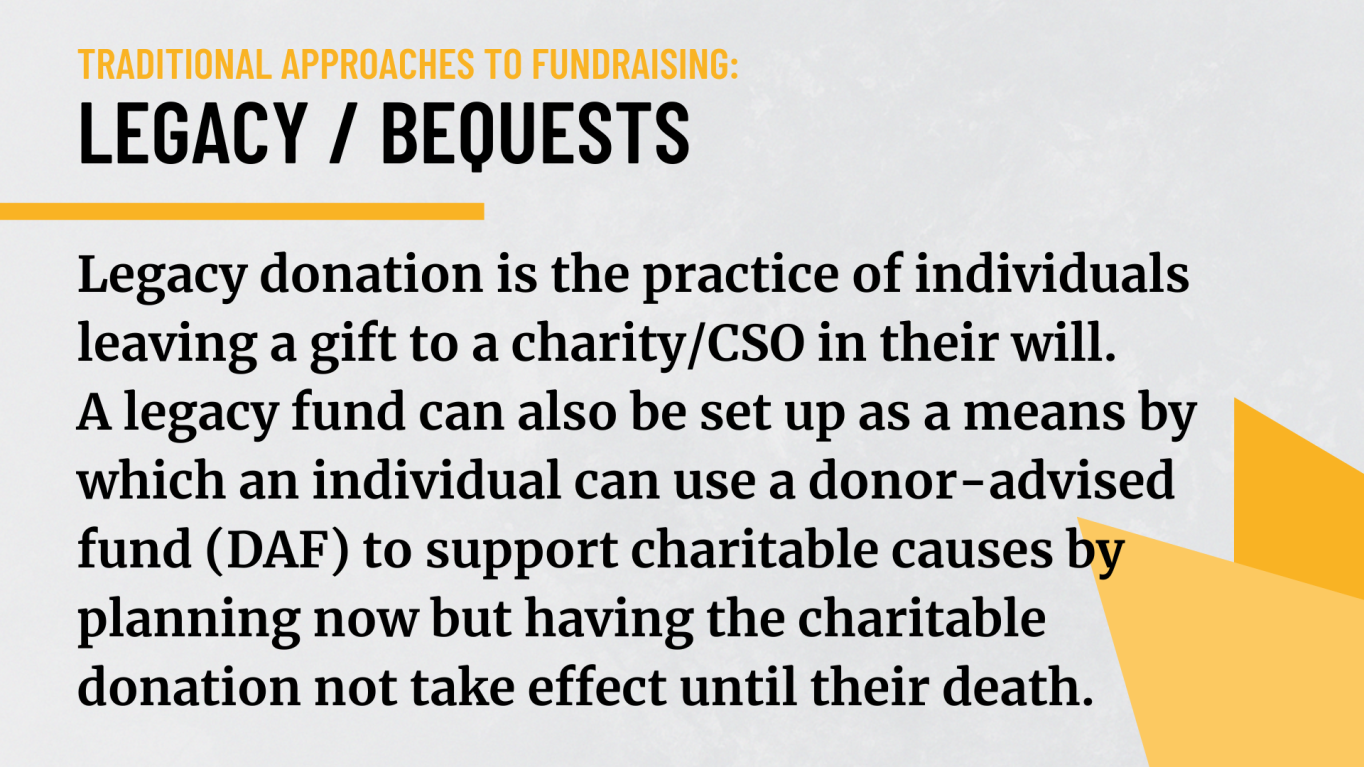
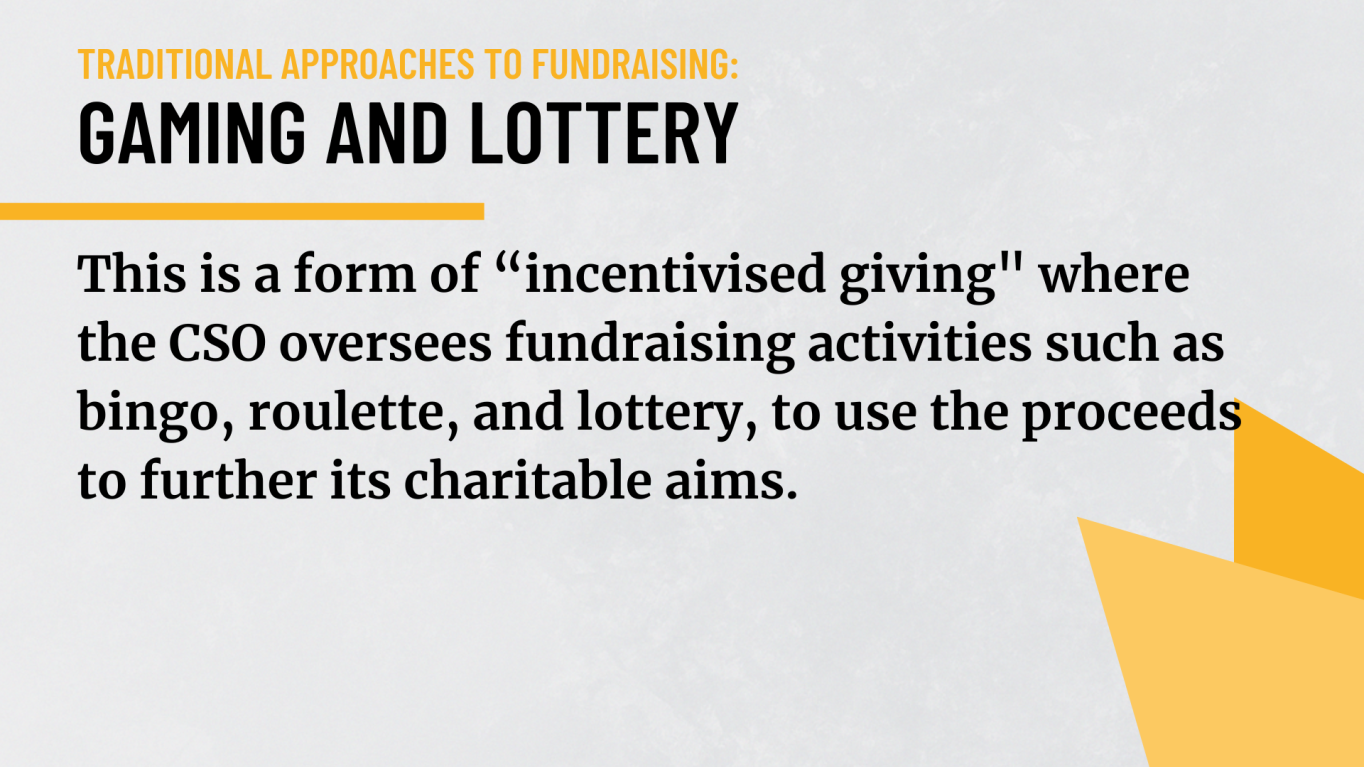
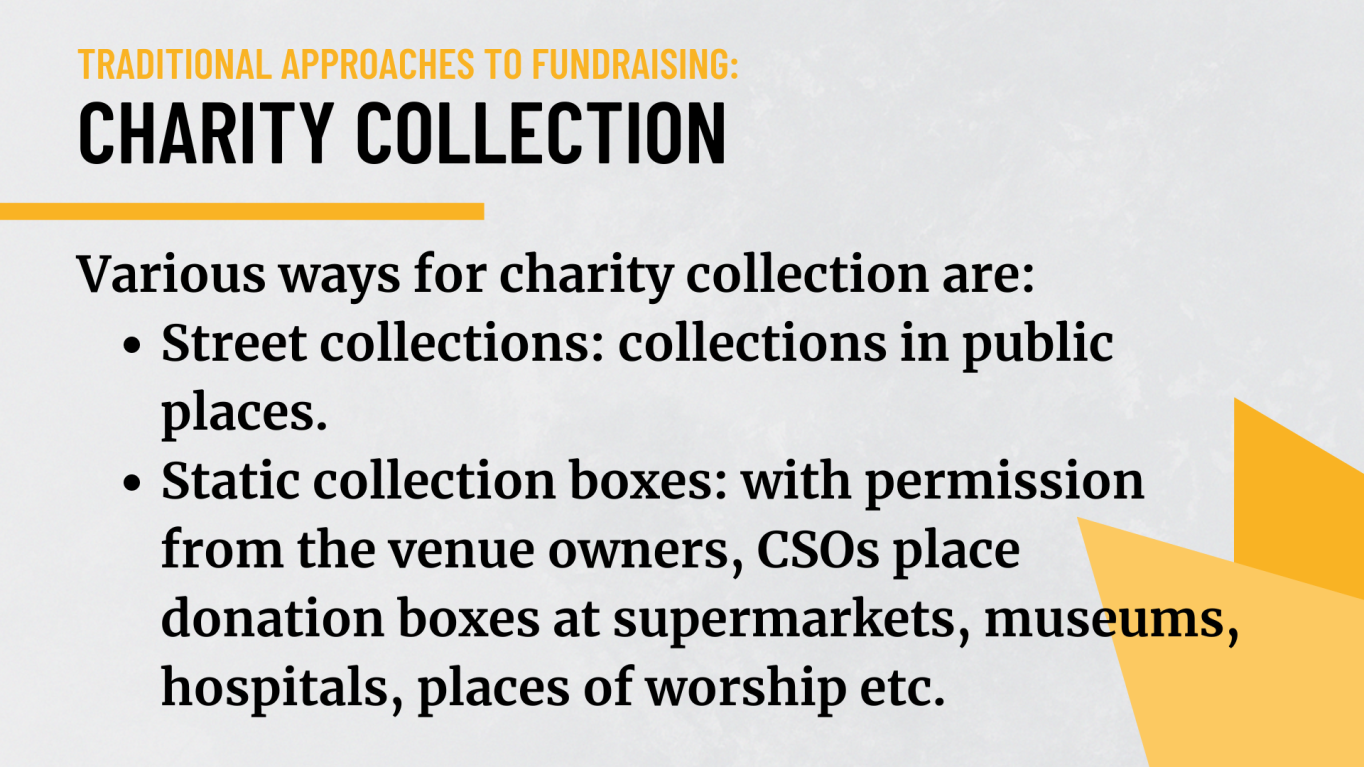
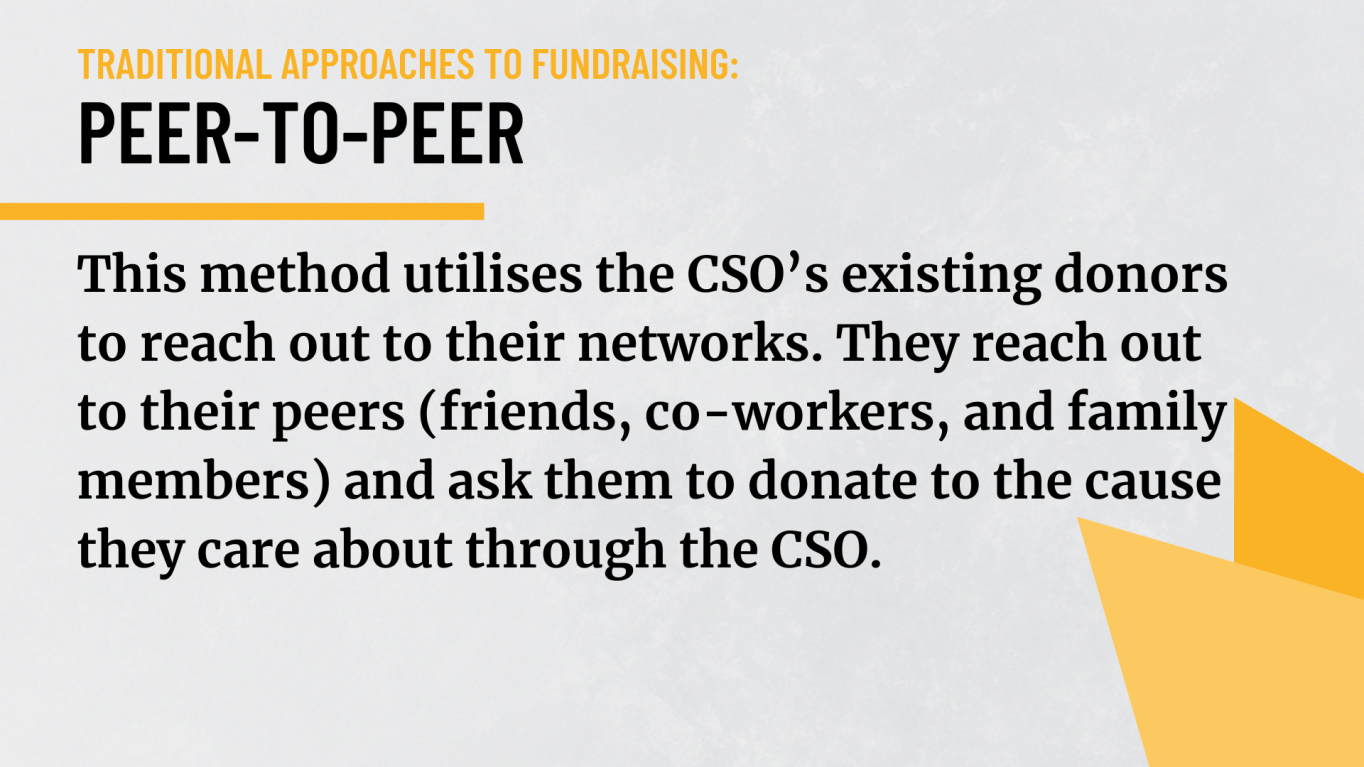

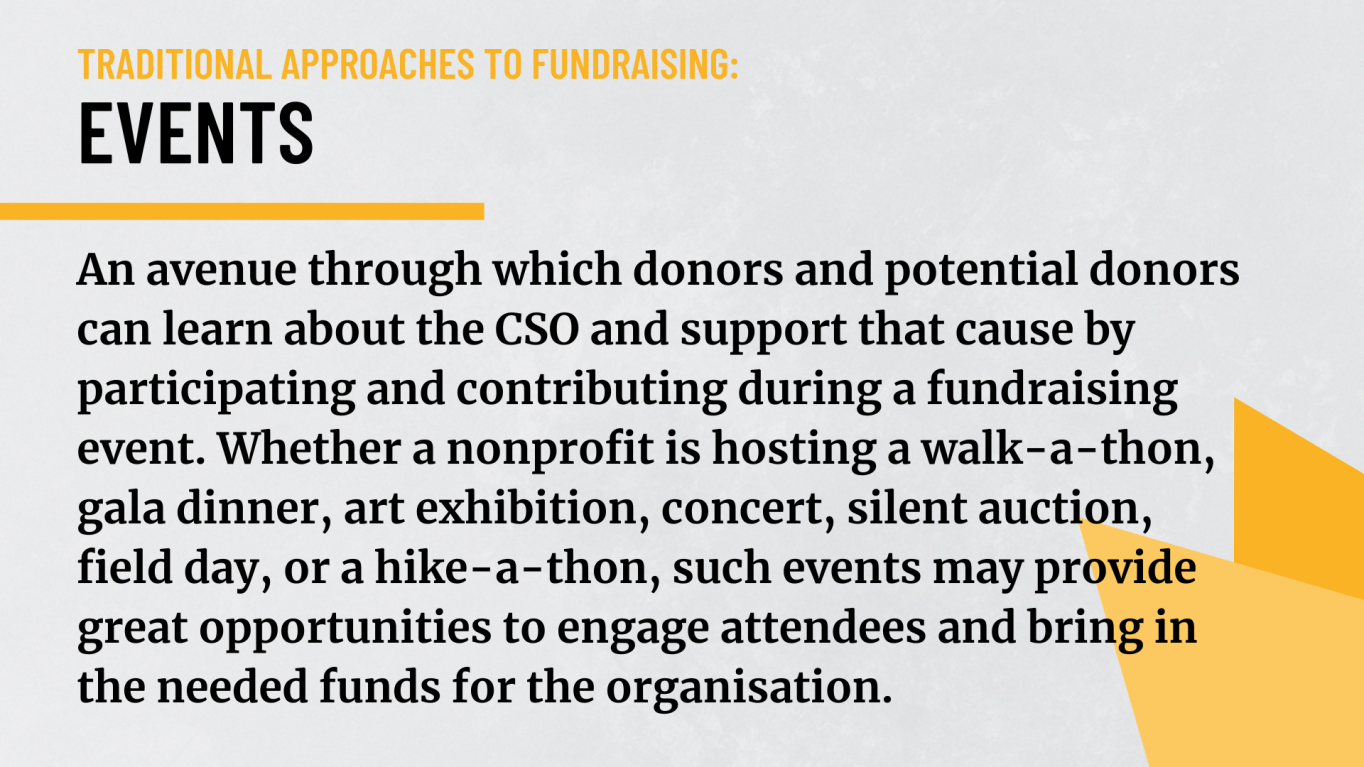
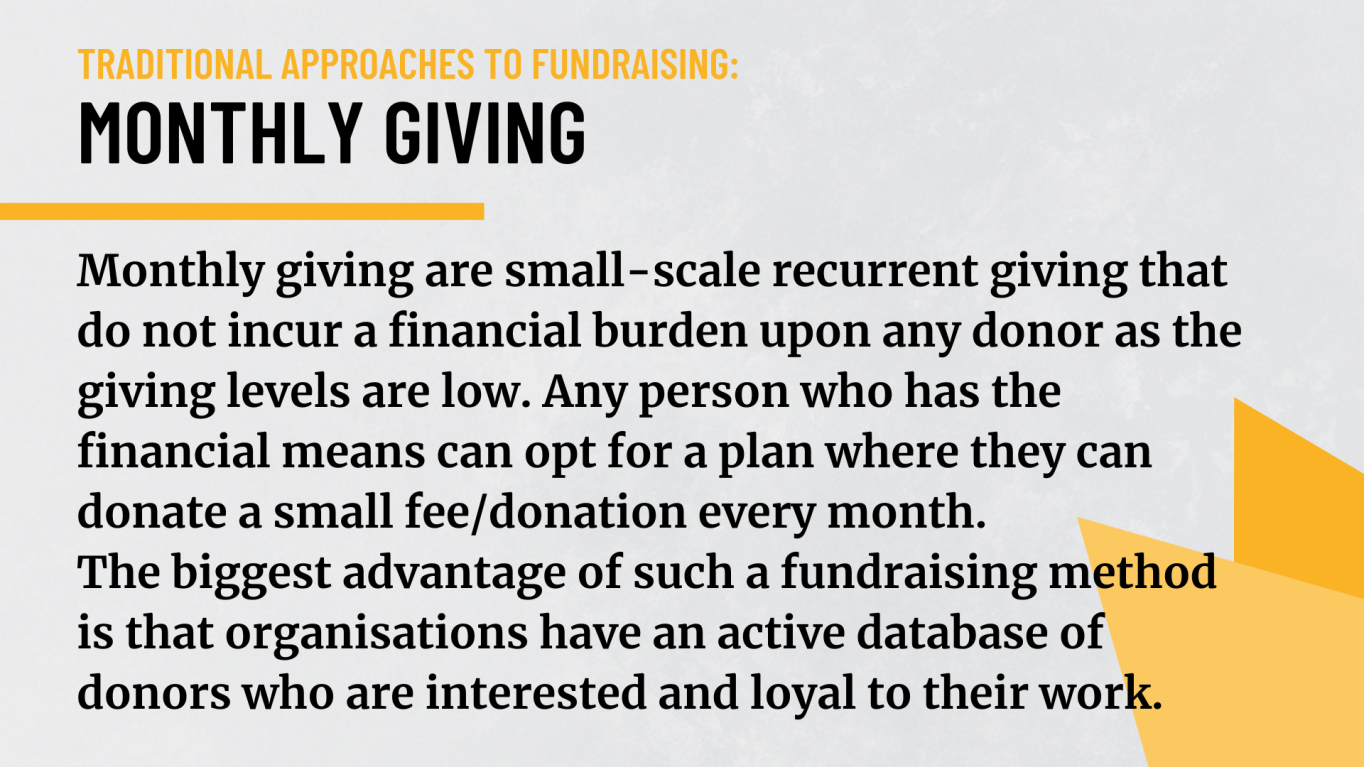
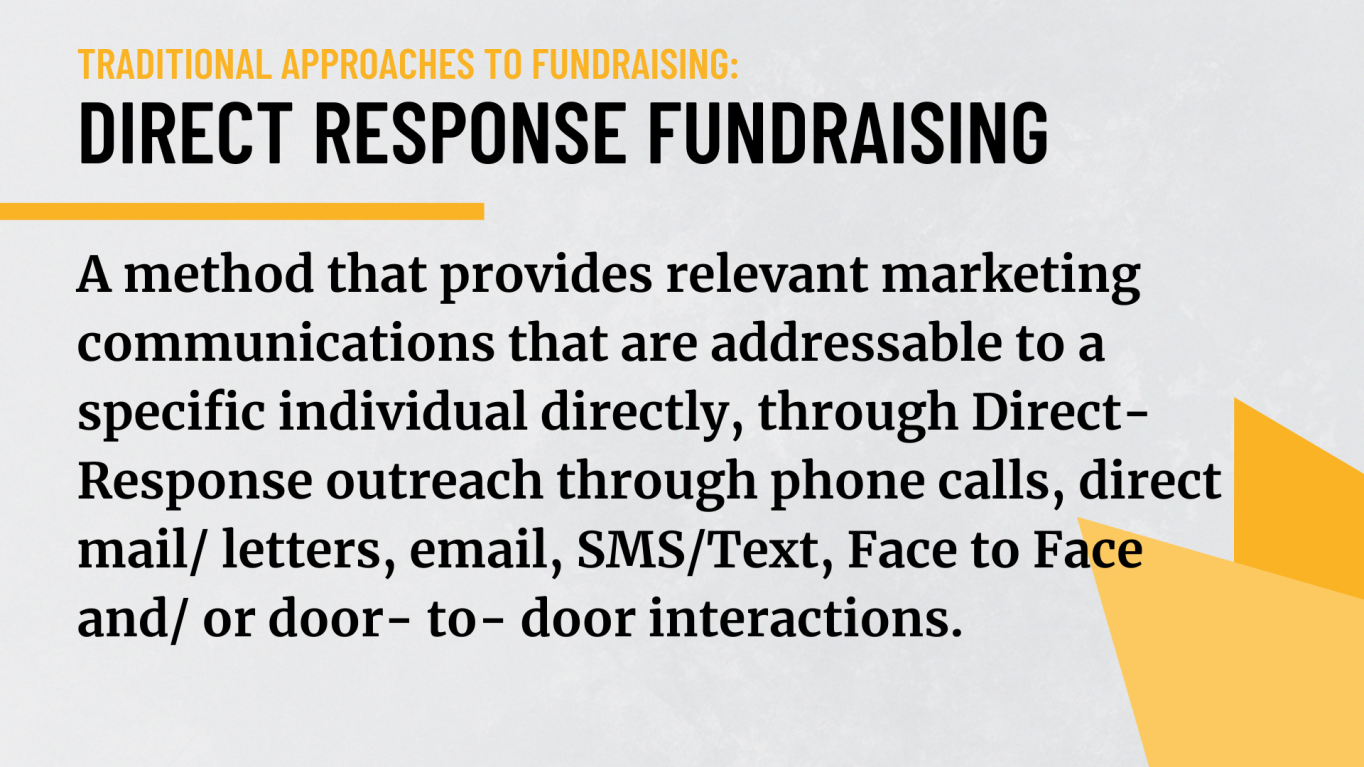
Increasingly, movements and CSOs rely on new, digitally-based techniques to encourage giving and raise funds. Use of digital technologies opens new horizons for CSOs to engage more people and conduct more targeted outreach.
Did you know? In January 2024, a total of 5,35 billion people around the world were using the internet, equivalent to 66,2% of the world’s total population. 94,2% of them use social media every month, which equals 62,3% of all the people on earth.
Any online form or process that allows people to financially contribute to the causes they care about can be considered digital fundraising. Digital fundraising methods include social media advertising, crowdfunding and segmented email marketing. Through digital technology, CSOs can collect and process data to identify donor segments interested in a particular cause, analyse motivations for giving, and many more demographic and psychographic information. For successful digital fundraising, CSOs must have a well-designed and inspiring website in place, where they can communicate their objectives and results and provide transparency on how mobilised resources are utilised. Furthermore, CSOs need to make use of payment services provided by banks or third parties to enable digital transactions, e.g. linked to a “donate” button on the website or social media.
Web 3.0, also known as the third-generation internet, is the next evolution of the World Wide Web called the Metaverse. It combines components of social media, gaming, virtual reality (VR), augmented reality (AR), Artificial Intelligence (AI), cryptocurrencies, and non-fungible tokens (NFTs). CSOs can use these tools and platforms to raise funds. Despite the ‘crypto-winter’ in the later part of 2022, many CSOs have still benefited from crypto-philanthropy.
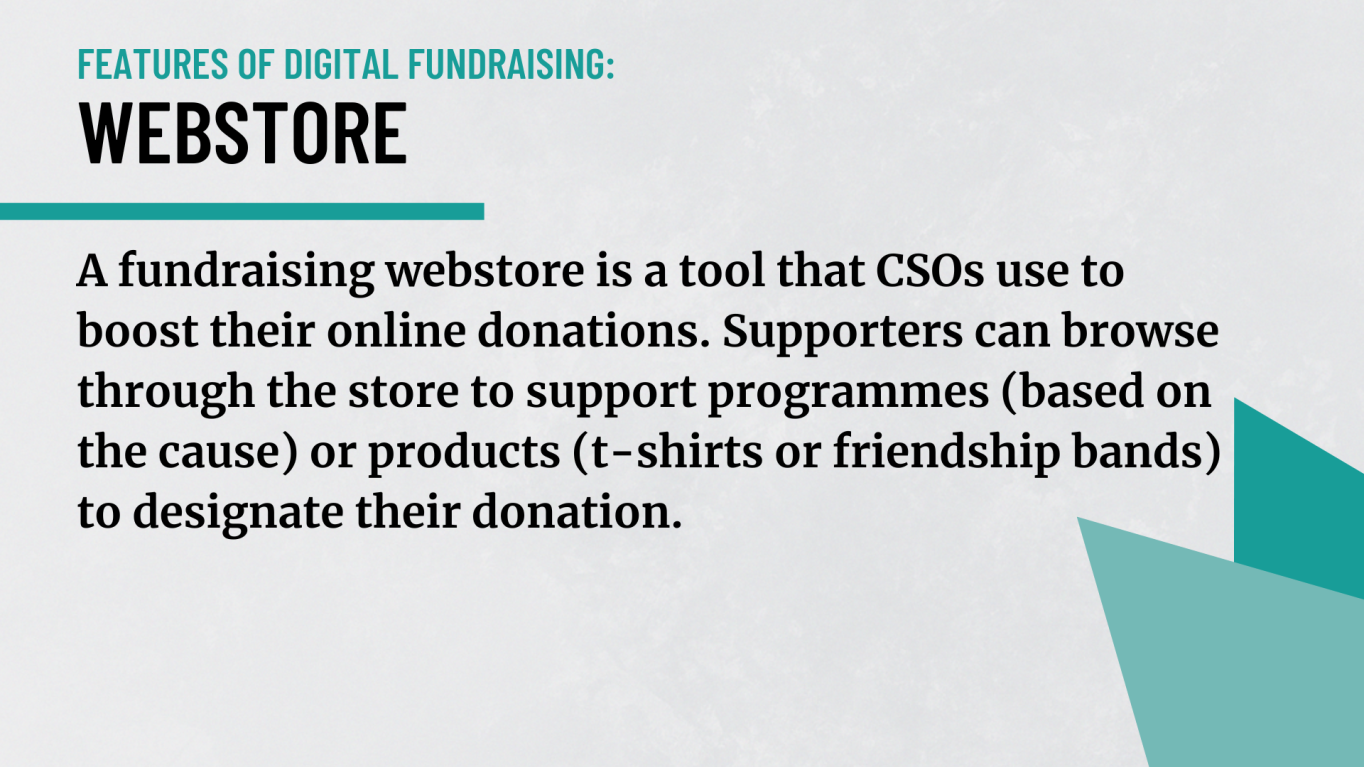

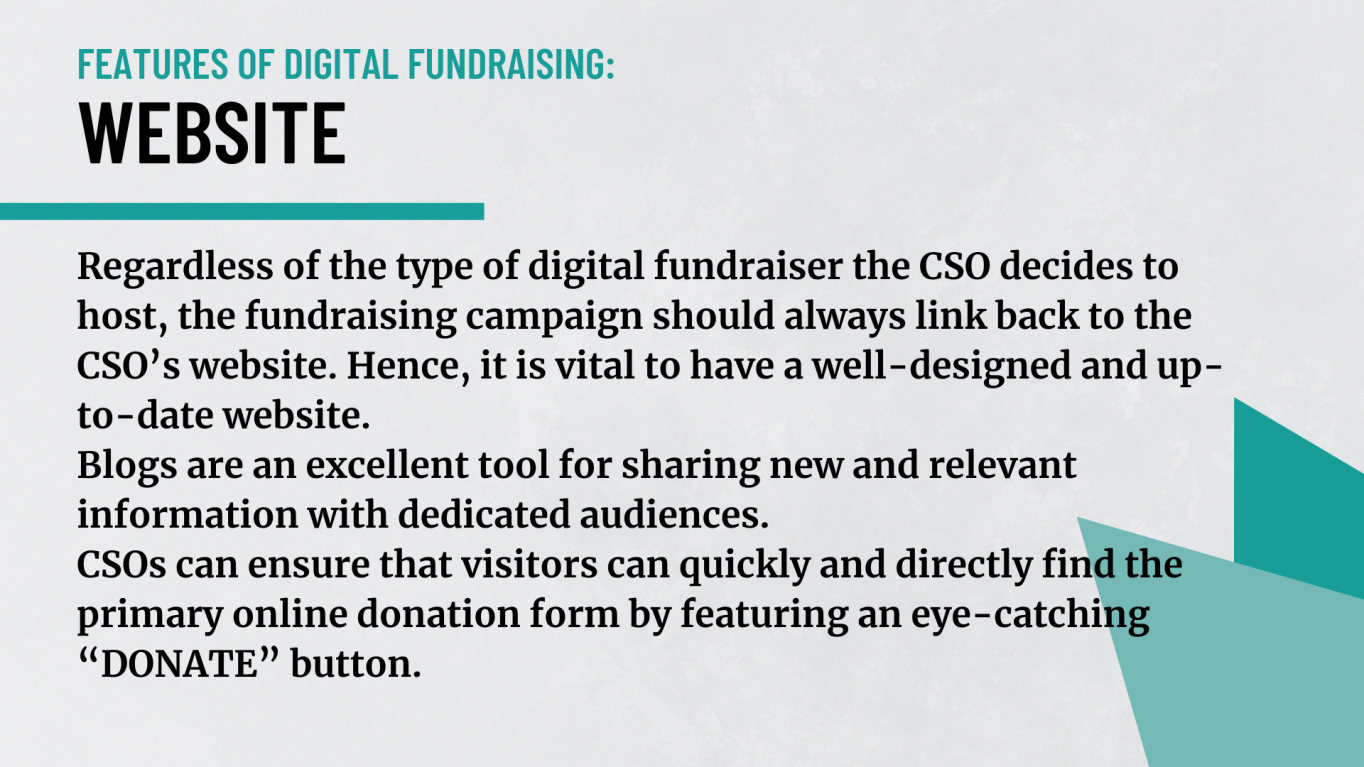


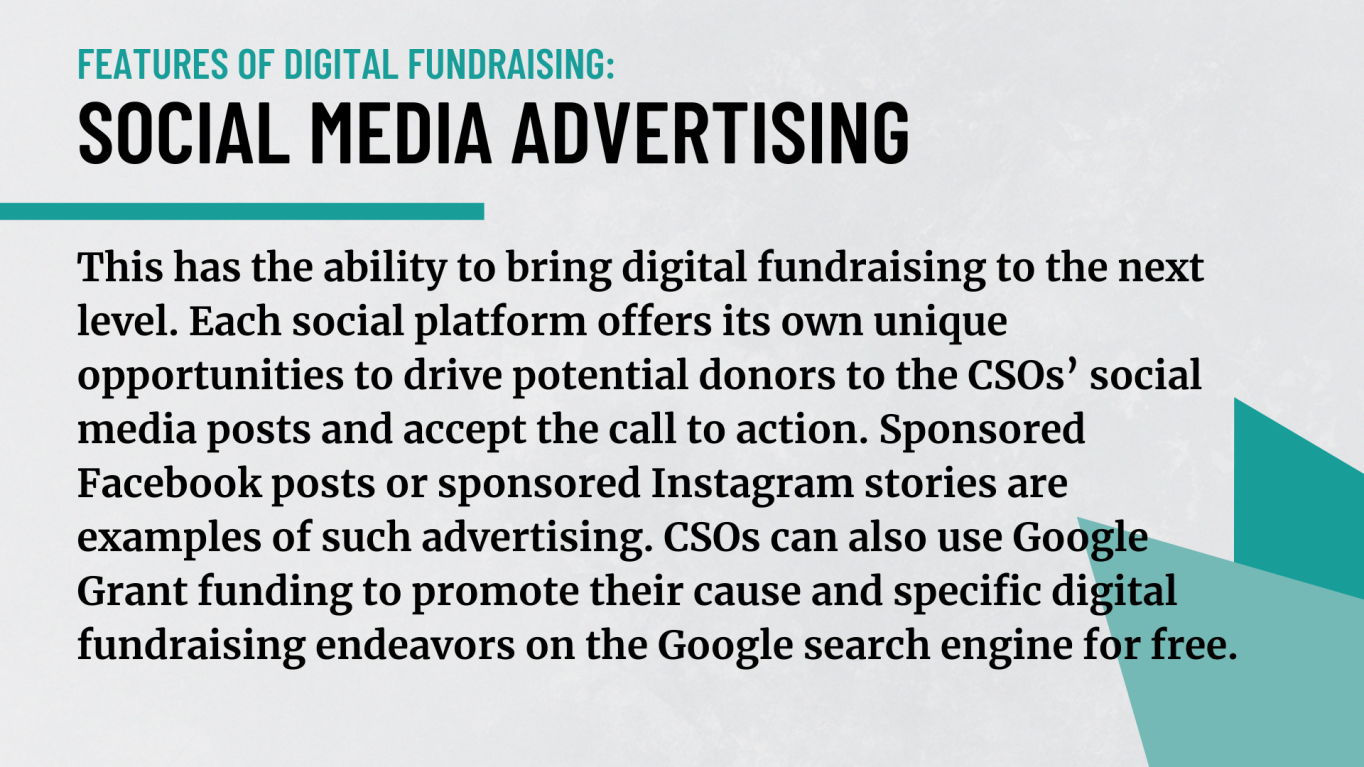
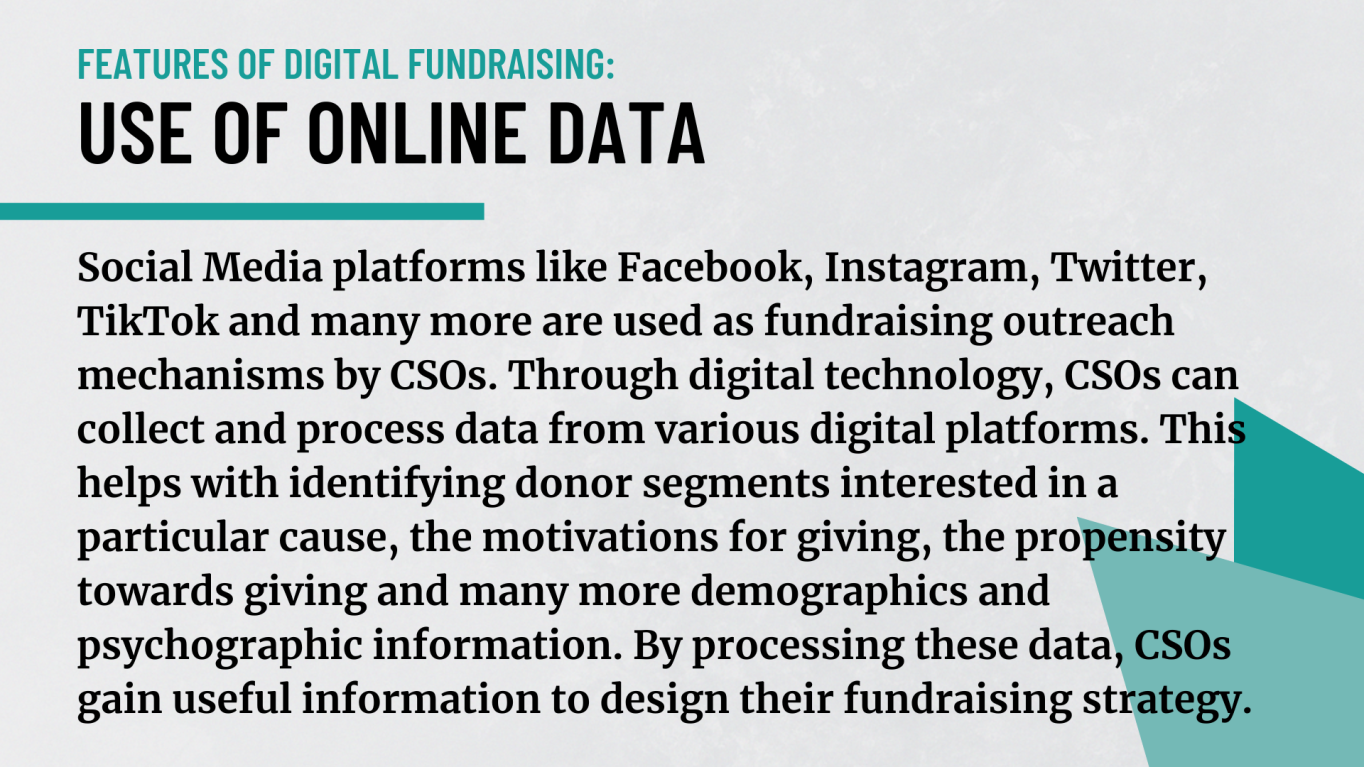
What do new technological developments mean for CSOs?
The great thing about technological developments is that they benefit different types of CSOs in different ways:
- CSOs that have the capacity to conduct large digital fundraising campaigns can collect and process data to gain useful information to design and improve their fundraising strategy.
- The spread of crowdfunding platforms decentralised and democratised philanthropy and offers new opportunities to attract resources without the need for expensive campaigns. Gofundme is the biggest platform globally, but there are also platforms that are specifically set up to serve CSOs and grassroots groups, such as Chuffed, Global Giving (which combines a crowdfunding platform with fundraising training and coaching) and the Ghanaian Yen Somu Bi, aimed at Ghanaian community-based organisations.
- In some restrictive contexts, cryptocurrencies provide a solution to CSOs that cannot receive foreign funding, for example in Afghanistan.
- Digital platforms, such as Open Collective, can also enable unregistered groups to mobilise and receive resources.
On the other hand, it is important to recognise that the use of digital technologies brings new risks, challenges and considerations. These include the following:
- Cryptocurrencies have negative implications on the climate, and it is important to consider this when a CSO designs its fundraising strategiesCr.
- AI is a by-product of human intelligence and therefore it is subject to human biasedness. By its own nature, the machine not only replicates but amplifies the bias.
- Profiling of donors may be done through the illegal obtainment or sharing of data that violates the right to privacy and/or data protection.
How can machine-learning algorithms and automated decision-making help CSOs' fundraising?
AI can handle large quantities of data. Algorithms and machine learning can find patterns in the data and develop predictive models that help fundraisers. AI in fundraising can be used to predict donor behaviour, identify enhancement opportunities, automate repetitive tasks, eliminate manual data entry, and improve donation forecasting accuracy. AI can boost efficiency and effectiveness, while reducing the costs of fundraising by the CSO.
An enabling environment for fundraising is important to strengthen - rather than hinder - CSOs’ ability to raise funds and stimulate people and institutions to contribute to a better world.
The legal and policy environment for private giving is regulated by numerous laws: framework laws on CSOs, money collection, taxation, data protection, consumer protection, accounting, banking, games of chance, anti-money laundering, counter terrorism financing, online content regulation. In many countries it is undergoing a stress-test due to restrictive measures adopted by governments.
Let’s take a closer look at various levels of these frameworks:
International laws
CSOs’ right to secure resources is an integral part of the right to freedom of association guaranteed by various international instruments. Freedom of association is guaranteed by numerous international standards, including the Universal Declaration of Human Rights, International Covenant on Civil and Political Rights, the European Convention on Human Rights, the American Declaration of the Rights and Duties of Man and the African Charter on Human and Peoples’ Rights. According to the UN Human Rights Committee interpreting article 22 of the International Covenant on Civil and Political Rights, “the right to freedom of association relates not only to the right to form an association, but also guarantees the right of such an association to freely carry out its statutory activities. The protection afforded by Article 22 extends to all activities of an association. . . .” The Human Rights Committee stressed that funding restrictions that impede the ability of associations to pursue their statutory activities constitute an interference with article 22 of the ICCPR. Thus, raising funds, including through individual and corporate philanthropy, is considered to be a statutory activity that is essential to maintaining the financial sustainability of CSOs. This is also further highlighted by UN Special Rapporteur on the rights to freedom of peaceful assembly and of association.
National-level laws
Based on international human rights law, states have the responsibility to respect, protect and facilitate the right to freedom to access resources by CSOs. They must ensure an enabling environment for philanthropy to thrive. States can encourage private giving, for example by providing tax benefits to individual and corporate donors, by ensuring a suitable legal framework for both fundraising and grantmaking organisations and by removing any bureaucratic barriers that CSOs may experience, e.g. in obtaining a permit for organising a large fundraising concert in a public space.
Some examples are:
- Legislation in the Czech Republic and Ukraine exempts SMS donations to CSOs from value added tax.
- In Romania, companies that grant sponsorships to CSOs under the Romanian Sponsorship Law can deduct these sponsorships from the profit tax up to 20% of the profit tax due.
Governments can support an enabling environment for giving not only by laws, but also in practice:
- In Belgium, the Governments of Flanders and Brussels co-finance the operation of a civic crowdfunding platform called Growfunding, which has so far mobilised more than 75,000 people to support over 400 local projects.
However, some states impose obligations or requirements on CSOs that affect their fundraising activities. They oftentimes justify such measures to prevent fraud and promote transparency in fundraising, but also to serve other purposes, such as data protection, child protection or consumer protection related to advertisements. It may be done at states’ own initiative or to comply with international laws and standards, such as EU regulations and recommendations of the FATF concerning anti-money laundering and countering terrorism financing.
In any case, states must ensure that any restrictions on CSOs’ right to access funding are provided for by law and are necessary and proportionate. This means that restrictions must:
- Be clearly (and not only vaguely) laid down in a law;
- Have a legitimate goal, such as protecting national security, public safety or the rights and freedoms of others;
- Be truly effective; and
- Be the least intrusive means and not excessively burdensome.
A legitimate goal, such as countering terrorism financing, should not be used to overregulate philanthropy, impose excessive control on CSOs or violate for example the right to privacy of CSOs and their donors.
Fundraising sector standards
In parallel, CSOs are equally shaping the environment for giving by adopting higher standards and self-regulating their own practices. Self- and co-regulatory standards help to build up and maintain what is most important for people when they donate to a cause: trust. An example of a comprehensive standard is the Code of Fundraising Practice, developed by the Fundraising Regulator, the independent regulator of charitable fundraising in England, Wales and Northern Ireland.
ECNL's Fundraising Principles provide a global overview of current trends in fundraising regulation and self-regulation. You can also explore the Good practices in digital fundraising.
Launching a fundraising campaign: what can be the legal barriers?
Let’s imagine you are a group that runs a homeless shelter and want to launch a public collection campaign to raise funds for food and equipment. What can you expect?
- Lengthy administrative processes. First you need to obtain permission from the authorities to raise funds through boxes in supermarkets or collect donations online.
- Bank delays. Banks may also require additional documentation to open a sub-bank account to fundraise; this delays transactions.
- Excessive oversight for foreign donations. If you want to receive funding from another country, you may need to request permission from the authorities and be subjected to burdensome oversight.
- Identification of donors. In some countries, laws require that all donors are identifiable. This makes the use of certain fundraising tools such as collection boxes or crowdfunding campaigns nearly impossible as one cannot identify every person who has dropped a penny in a box.
- Prohibition of anonymous donations. This is particularly problematic for CSOs that work in more restrictive environments or for those who support causes which are considered controversial in a community (e.g., LGBTQIA+). Being able to accept anonymous or pseudonymous donations and utilise them without being stymied by a local official can make a world of difference in terms of advocacy, safety, and security for activists, groups and donors.4
- Compliance with AML/CFT measures. Governments often justify their request for detailed information under the anti-money laundering and counter terrorism financing framework. However, such measures disrupt the legitimate activities of CSOs and are neither risk-based, proportionate nor effective.
What can you do against restrictive fundraising laws and practices?
- Conduct regular monitoring of the environment for philanthropy. For example, ECNL and ICNL assessed the legal environment for CSO financial sustainability in Georgia. You can find more information in our forthcoming Learning Center package on Monitoring.
- Prepare an analysis of a draft law. For example, TUSEV, with support from ECNL, anaysed the 2020 counter-terrorism law that further restricted public collection in Turkey.
- Convene CSOs and possibly other stakeholders and create a platform to promote philanthropy and push back any restrictions. For example, the Platform for Promotion and Development of Philanthropy in Moldova directly contributed to the 2022 amendment to the Moldovan Law on Philanthropy and Sponsorship.
- Raise the awareness of the international community about the restrictive (draft) law, including through the UN special procedures, the Council of Europe and via bilateral relations. For example, the Council of Europe and the United Nations issued strong statements regarding the draft foreign agent laws in Georgia.
- Challenge the law at the national, regional and international levels. The case of Hungary illustartes how EU law can safeguard CSOs’ access to funding. More information on how to use EU law to safeguard your right to mobilise resources can be found in our EU Law Handbook.
Testimonials

Giving is an act of power.

Values and emotions are stronger drivers of philanthropy than wealth and income. Hence CSOs and their fundraising team need to be strategic in their communications and build a diversified fundraising portfolio. The growth in innovations and adoption of fundraising through digital channels and devices, Web3.0, crypto philanthropy, the robust developments in established fundraising methods, as well as policy advocacy all make it an exciting time to be fundraising for causes.



